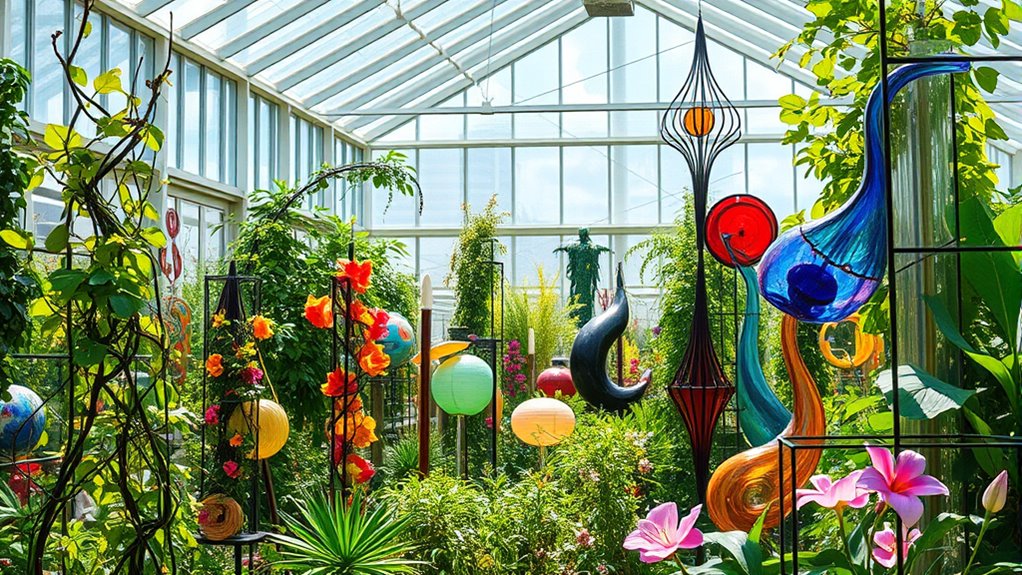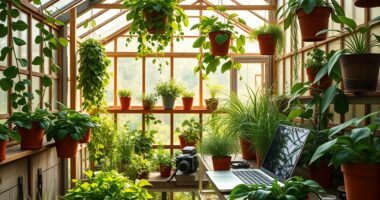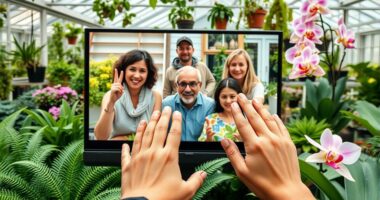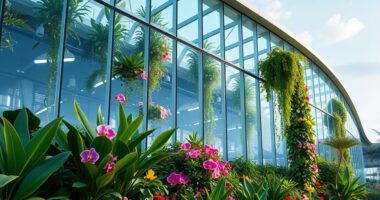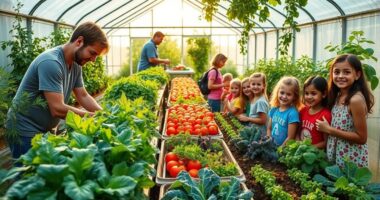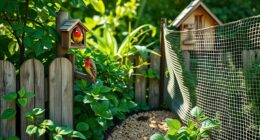Greenhouse art offers stunning installations worldwide that combine botanical beauty with creative designs. You’ll discover vibrant botanical sculptures, immersive light displays, and eco-friendly projects made from recycled materials. Iconic destinations like the Eden Project and Kew Gardens showcase innovative, harmonious art that transforms outdoor spaces into interactive masterpieces. As technology and sustainability converge, the future promises even more mesmerizing, community-driven experiences. Keep exploring, and you’ll uncover how these stunning pieces inspire environmental awareness and artistic innovation around the globe.
Key Takeaways
- Greenhouse art combines botanical installations, sculptures, and innovative design to create visually stunning environments worldwide.
- Iconic locations like Eden Project and Kew Gardens showcase sustainable, artistic structures blending nature and creativity.
- Use of light, color, and technology enhances immersive experiences within greenhouse settings.
- Eco-friendly projects utilize recycled materials and organic designs to promote environmental responsibility.
- Future trends include augmented reality and community-driven interactive exhibits inspiring global artistic innovation.
Enchanting Botanical Art Installations in City Parks
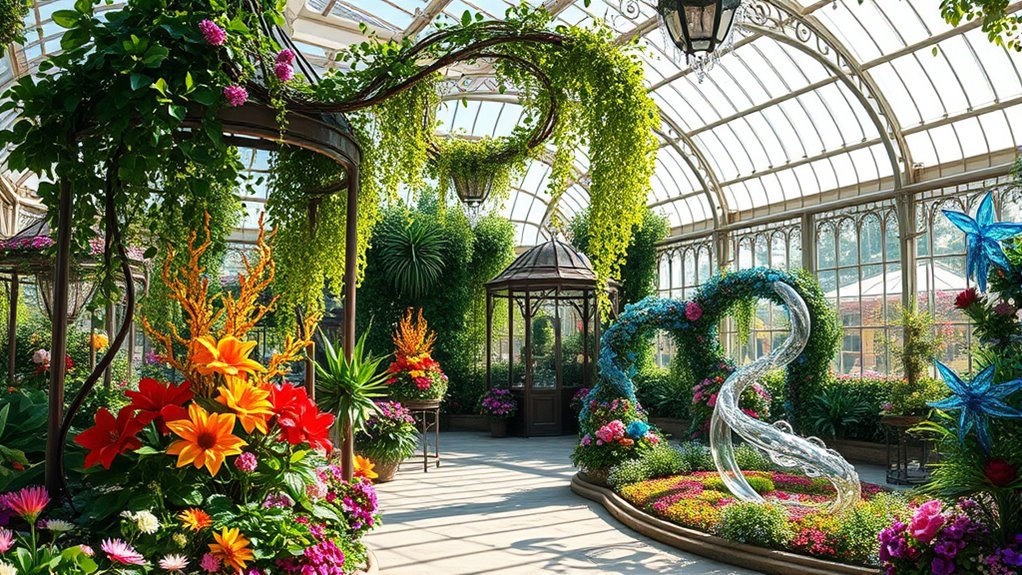
City parks now showcase stunning botanical art installations that fascinate visitors and transform outdoor spaces into living works of art. These installations emphasize innovative garden design, blending natural elements with artistic vision.
City parks feature captivating botanical art installations that blend natural beauty with creative design.
You’ll notice botanical sculptures crafted from vibrant flowers, greenery, and natural materials, creating striking focal points. These sculptures highlight creativity and skill, turning ordinary gardens into extraordinary displays. Additionally, the use of natural materials in these installations enhances their authenticity and visual appeal. Many of these projects are inspired by cultural narratives, making each installation a storytelling masterpiece. The integration of garden design principles ensures that these botanical artworks complement their surroundings seamlessly, elevating the overall aesthetic experience.
As you stroll through these parks, you’ll see how carefully curated plant arrangements form intricate shapes and patterns, elevating the aesthetic appeal. This combination of botanical sculptures and aesthetic principles demonstrates how thoughtful planning can elevate outdoor spaces into artful environments. Moreover, the focus on cybersecurity in the design and installation process helps protect these public artworks from vandalism and cyber threats, ensuring their longevity and safety. The fusion of botanical sculptures and thoughtful garden design invites you to experience nature in a new, inspiring way.
It’s a celebration of artistry and horticulture, making city parks lively, engaging, and perfect for exploration and admiration.
Immersive Light and Color Exhibits in Greenhouses

Greenhouses now offer immersive light and color exhibits that elevate botanical displays into sensory experiences. You’ll be mesmerized by LED light displays that transform the space into vibrant, dynamic environments. These exhibitions often feature:
- Stunning color changing installations that shift hues seamlessly, enhancing plant beauty
- Interactive displays where visitors influence the lighting and colors in real-time
- Multi-sensory setups combining sound, light, and visual effects for an immersive journey
- Themed light shows synchronized with seasonal or botanical events
These exhibits create a spellbinding atmosphere, making each visit unique. The innovative use of LED technology and color changing installations invites you to see greenhouses as more than just plant habitats—they become living, breathing art spaces filled with light and color. Incorporating atmospheric lighting enhances the overall experience by creating mood and ambiance within these botanical environments. Additionally, the use of technological advancements in lighting design allows for more precise control and customization of visual effects, enriching visitor engagement. Modern AI-powered lighting systems can adapt in real-time to changes in environment or visitor interaction, further elevating the sensory experience. This integration of advanced technology demonstrates how lighting control systems are transforming botanical exhibits into dynamic artistic environments. Moreover, leveraging local innovations in lighting technology helps develop more sustainable and energy-efficient exhibits that minimize environmental impact.
Sculptures and Structures Blending Nature and Creativity

As artists and designers increasingly blur the lines between nature and creativity, they craft sculptures and structures that seamlessly integrate into botanical environments. Biological sculptures emerge as living art, shaped from plants and natural materials, creating dynamic, evolving displays. These sculptures often mimic organic forms, blending effortlessly with their surroundings. Organic architecture takes this integration further, designing structures that resemble natural growth patterns, like twisting vines or flowing water. By combining biological sculptures with organic architecture, creators produce installations that feel part of the landscape rather than separate from it. This approach celebrates nature’s beauty while showcasing human ingenuity, resulting in stunning, immersive environments. Incorporating biological sculptures into greenhouses enhances their aesthetic and ecological harmony, transforming them into living, breathing works of art. Additionally, utilizing organic architecture principles can foster a more sustainable and eco-friendly environment, emphasizing harmony with nature. Embracing eco-friendly design can further enhance these installations’ sustainability and environmental impact, promoting sustainable development in artistic and architectural practices.
Eco-Friendly Art Projects Using Recycled Materials
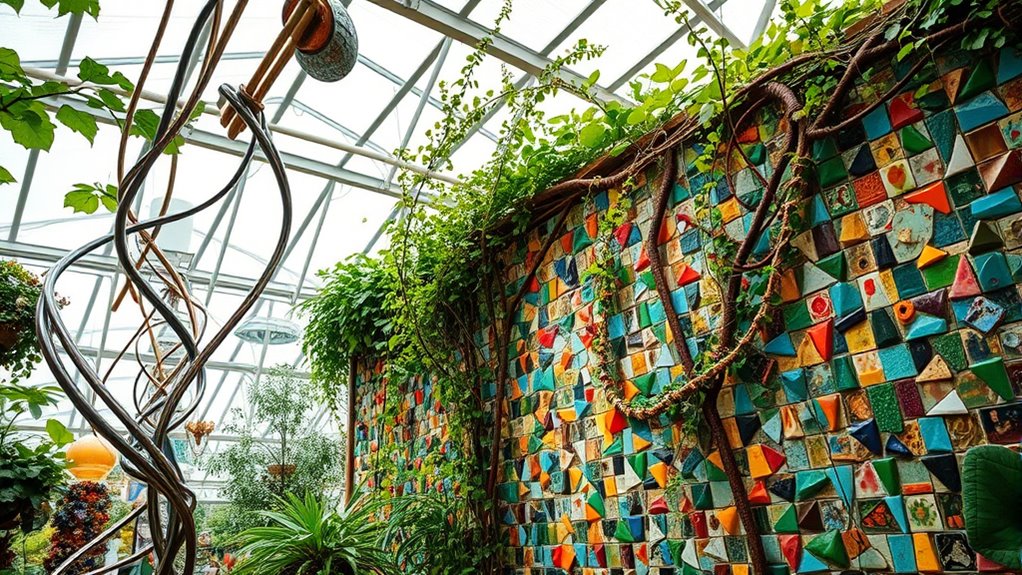
You can make a powerful statement by choosing sustainable materials for your art projects. Reusing and repurposing items sparks creativity and reduces waste. Incorporating eco-friendly techniques can elevate your artwork while supporting environmental conservation. Additionally, utilizing secure payment processing ensures smooth transactions for art sales and exhibitions.
Sustainable Material Choices
Have you ever considered how art can thrive using recycled materials? Choosing sustainable options emphasizes eco-friendly practices.
First, opt for biodegradable coatings that break down naturally, reducing long-term waste. Sustainable material choices can significantly decrease the environmental impact of your installations.
Second, incorporate natural fiber composites, such as hemp or jute, to add strength and sustainability. These materials are renewable and biodegradable, contributing further to eco-friendly art.
Third, select materials that are locally sourced to minimize transportation impacts.
Fourth, prioritize recycled metals or plastics that can be reshaped into new art forms. Utilizing recycled materials encourages creativity while supporting environmental conservation.
These choices not only reduce environmental footprints but also inspire innovation.
By focusing on sustainable materials, you create art that’s both beautiful and responsible.
Your work becomes a testament to eco-conscious creativity, proving that sustainability and artistry can go hand in hand.
Additionally, considering the material composition of your supplies ensures durability and enhances the overall impact of your eco-friendly artwork.
Creative Reuse Techniques
Creative reuse techniques transform discarded materials into stunning, eco-friendly artworks that showcase innovation and sustainability. By applying recycling techniques, you can repurpose items like plastic bottles, metal scraps, and old textiles into captivating installations. Material innovation plays a vital role, as artists find new ways to give everyday waste a fresh purpose. You might create sculptures from shattered ceramics or murals from torn paper, turning trash into treasure. This approach not only reduces waste but also challenges traditional notions of beauty and functionality. As you experiment with different materials, you develop unique methods that highlight environmental consciousness. Incorporating upcycled materials into your art projects further emphasizes the importance of sustainability in creative reuse. Embracing creative reuse allows you to produce impactful art that promotes sustainability while inspiring others to rethink waste and resourcefulness.
Iconic Greenhouse Art Destinations Around the Globe
Around the world, several greenhouse art destinations stand out for their stunning architecture and innovative designs. These sites showcase the harmony of urban horticulture and botanical design, drawing visitors with their iconic structures. Here are four must-visit locations:
Discover stunning greenhouse art destinations showcasing innovative architecture and botanical beauty worldwide.
- Eden Project (UK): Known for its geodesic domes, it combines sustainable architecture with lush plant displays.
- Nong Nooch Tropical Botanical Garden (Thailand): Features elaborate greenhouses supporting vibrant tropical flora and artistic landscape design.
- Kew Gardens (UK): Its iconic Palm House exemplifies historic botanical design and modern urban horticulture integration.
- Château de Chenonceau (France): The greenhouse-inspired gardens highlight exquisite botanical artistry nestled in historic architecture.
These destinations inspire with their blend of artistic expression and botanical innovation.
Future Trends in Greenhouse Artistic Expressions
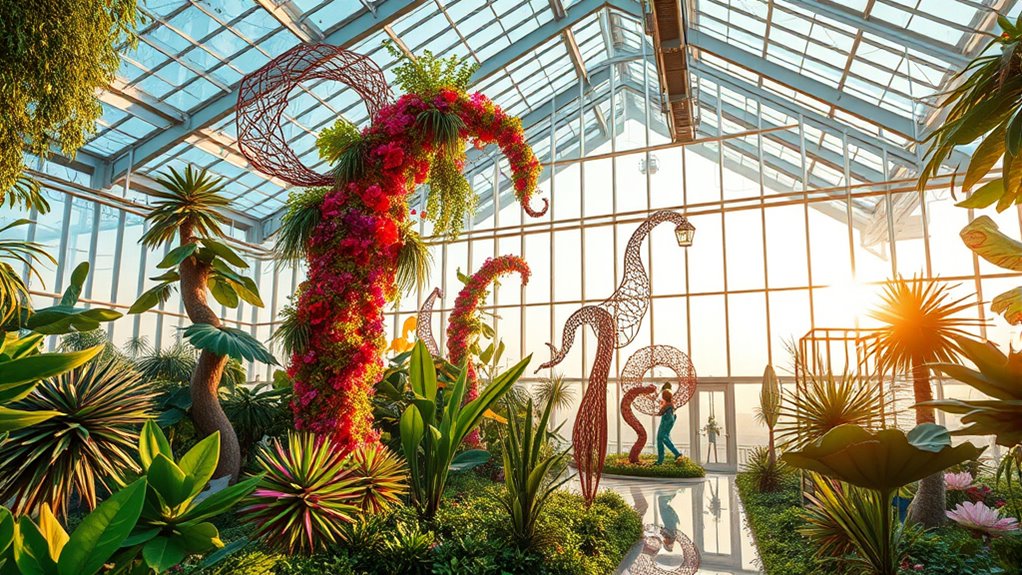
As technology advances, greenhouses are evolving into dynamic spaces where art and innovation intersect, opening new avenues for creative expression.
Expect to see more technological innovations like augmented reality and interactive installations that engage visitors directly. These tools will make greenhouse art more immersive, allowing audiences to experience art on a deeper level.
Additionally, future trends emphasize community engagement, transforming greenhouses into collaborative hubs where local artists and visitors contribute to ongoing installations. This participatory approach fosters a sense of ownership and connection, enriching the artistic landscape.
As these trends develop, greenhouse art will become more inclusive, innovative, and connected, blending cutting-edge technology with community-driven creativity to shape the future of this vibrant art form.
Frequently Asked Questions
How Do Greenhouses Influence Local Biodiversity Through Art?
You mightn’t realize it, but greenhouses influence local biodiversity by creating pollinator habitats and supporting native plant preservation.
When you incorporate art into these structures, you enhance awareness and appreciation for native species, encouraging community involvement.
These installations can attract pollinators, boost plant diversity, and protect local ecosystems.
What Are the Maintenance Challenges of Outdoor Greenhouse Art Installations?
You might think outdoor greenhouse art is low-maintenance, but climate control and pest management pose real challenges. You’ll need to regularly monitor temperature and humidity to protect delicate installations, especially against extreme weather.
Pests can damage artwork or plants, so consistent pest management is essential. Without proper upkeep, installations can deteriorate quickly, so staying vigilant and adaptive is key to keeping your outdoor greenhouse art vibrant and intact.
How Do Artists Ensure Sustainability in Greenhouse Art Projects?
You guarantee sustainability in greenhouse art projects by choosing sustainable materials that minimize environmental impact.
You incorporate eco-friendly practices such as recycling, using renewable energy sources, and designing for longevity to reduce waste.
Can Greenhouse Art Be Used for Educational Purposes Effectively?
You can use greenhouse art effectively for education by creating interactive displays that engage visitors actively. These installations encourage community engagement, making learning about sustainability, plant biology, and ecology more immersive and memorable.
As you design these projects, focus on hands-on experiences and collaborative activities, ensuring learners of all ages can connect with the content. This approach transforms greenhouse art into a powerful tool for education and environmental awareness.
What Funding Options Are Available for Greenhouse Art Initiatives?
You can explore various funding options for greenhouse art initiatives, such as grant opportunities from arts organizations, environmental agencies, or local government programs.
Additionally, sponsorship programs from businesses interested in sustainability or community engagement can provide financial support.
Conclusion
Greenhouse art transforms ordinary spaces into extraordinary worlds, inviting you to experience nature’s beauty in innovative ways. Some might think these installations are fleeting or impractical, but they actually inspire sustainable creativity and deepen your connection to the environment. By supporting these projects, you help foster eco-conscious art that benefits both the planet and your soul. So, don’t miss out—embrace greenhouse art and see how it can brighten your world in meaningful, lasting ways.
